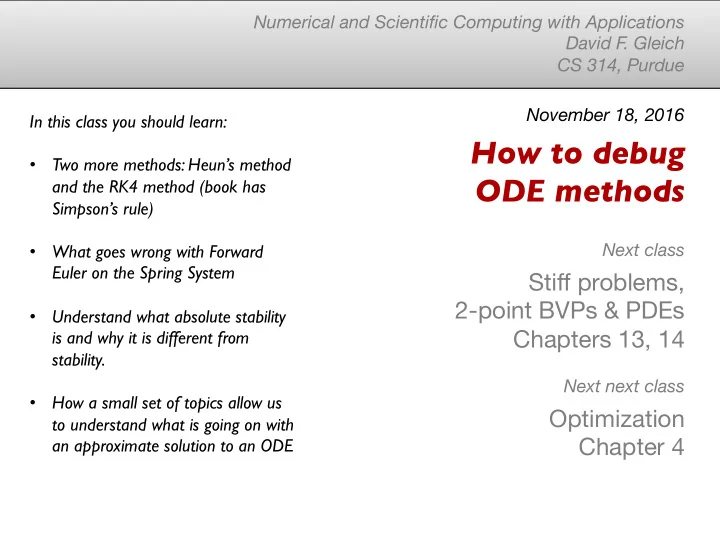

Numerical and Scientific Computing with Applications David F . Gleich CS 314, Purdue November 18, 2016 In this class you should learn: How to debug • Two more methods: Heun’s method ODE methods and the RK4 method (book has Simpson’s rule) Next class • What goes wrong with Forward Euler on the Spring System Stiff problems, 2-point BVPs & PDEs • Understand what absolute stability Chapters 13, 14 is and why it is different from stability. Next next class • How a small set of topics allow us Optimization to understand what is going on with Chapter 4 an approximate solution to an ODE
Terminology A “solver” for an ODE is called a Scheme • Method • Integator • Somewhat interchangeably. Scheme – how you go from step k to k+1 • Integrator/Method – Overall approach • y ∗ ( t ) is exact Notation y ( t ) ≈ y ( hk ) = y k |{z} | {z } exact comp. approx y ∗ ( t ) is exact if otherwise unclear
Writing Forward Euler as a scheme y (( k + 1) h ) = y ( kh ) + h f ( kh , y ( hk )) Summary of Notation y k +1 = y k + h f ( kh , y k ) y ∗ ( t ) is exact y k +1 = y k + h f ( t k , y k ) y ( t ) ≈ y ( hk ) = y k y k +1 = y k + h f ( t , y k ) |{z} | {z } exact comp. approx These are all meant to be equivalent ways of writing Forward Euler.
Heun’s method Summary of Notation y k +1 = y k + h / 2[ q 1 + q 2 ] y ∗ ( t ) is exact q 1 = f ( t k , y k ) y ( t ) ≈ y ( hk ) = y k q 2 = f ( t k + h , y k + hf ( t k , y k )) |{z} | {z } exact comp. approx q 2 q 1 h(k+1) hk
Runge Kutta methods Runge-Kutta 4 th order method “Related” to a Simpson integration rule. y k +1 = y k + h / 6[ q 1 + 2 q 2 + 2 q 3 + q 4 ] q 1 = f ( t k , y k ) q 2 = f ( t k + h / 2, y k + h / 2 q 1 ) q 3 = f ( t k + h / 2, y k + h / 2 q 2 ) q 4 = f ( t k + h , y k + q 3 ) Just a one step method! Julia makes it adaptive in the ode45 routine.
Recommend
More recommend